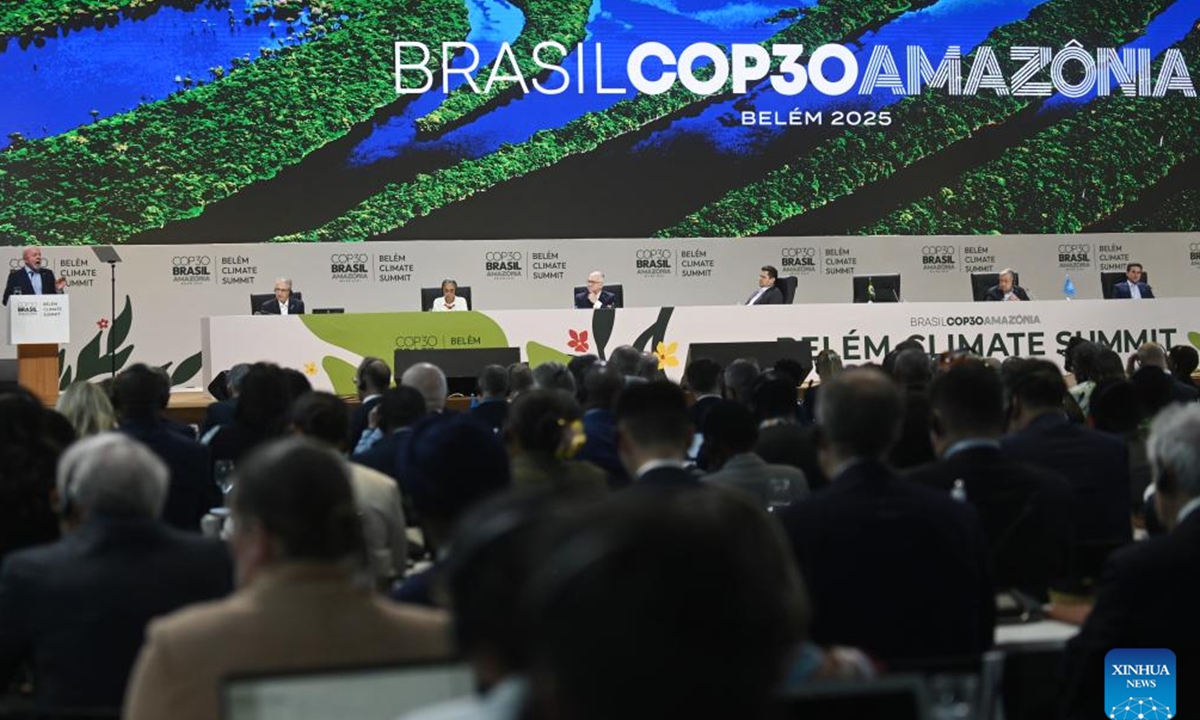Why China’s electric vehicles are chosen as the ‘official pick’ for the climate summit: Global Times editorial

Participants attend the Belem Climate Summit ahead of the 30th Conference of the Parties (COP30) of the United Nations Framework Convention on Climate Change in Belem, Brazil, Nov. 6, 2025. Photo: Xinhua
The 30th Conference of the Parties (COP30) of the United Nations Framework Convention on Climate Change will be held from November 10 to 21 in Belém, northern Bra…
Why China’s electric vehicles are chosen as the ‘official pick’ for the climate summit: Global Times editorial

Participants attend the Belem Climate Summit ahead of the 30th Conference of the Parties (COP30) of the United Nations Framework Convention on Climate Change in Belem, Brazil, Nov. 6, 2025. Photo: Xinhua
The 30th Conference of the Parties (COP30) of the United Nations Framework Convention on Climate Change will be held from November 10 to 21 in Belém, northern Brazil. Ahead of the conference, at the Belém Climate Summit, representatives from multiple countries arrived in Chinese vehicles. This has became a highly symbolic scene prior to the official opening of the conference. It reflects China’s efforts to promote a green, low-carbon transition, and deep involvement in global climate governance.
The “official debut” of China’s new energy vehicles is just one piece of the “Chinese green puzzle” at COP30. In Belém, located in the Amazon River basin, global media could easily find green and low-carbon Chinese elements. The New York Times described it this way: “the streets were gridlocked, but the clouds of exhaust were thinner than they had once been. The roads were dotted with electric cars, humming quietly in the midday traffic. Dignitaries zipped around in convoys made up of GWM pickup trucks. Electric buses shuttled passengers around the city.” These scenes have become an integrated part of daily life.
This year marks the 10th anniversary of the Paris Agreement, and COP30 represents a critical moment for all parties to move from negotiation to implementation. It has even been described as the “last chance to avoid an irreversible rupture in the climate system.” Over the past decade, global climate governance has faced many setbacks - from the US repeatedly “withdrawing from the agreement,” to developed countries’ prolonged failure to fulfill their funding commitments, as well as shocks brought by sudden geopolitical conflicts, a once-in-a-century pandemic, and trade wars. Even so, humanity has still made significant overall progress compared with 10 years ago - and behind this progress, no country has been a greater driving force than China. As The Wall Street Journal put it, China “is saving the Paris Climate Accord.”
China is recognized by the international community as one of the countries with the firmest will, the strongest actions, and the most remarkable results in fulfilling its emission reduction commitment, making it an undeniable doer in the global fight against climate change. This is something the international community is increasingly “seeing” and acknowledging. The Wall Street Journal believes that the plummeting cost of clean energy is helping offset a sharp drop in climate finance from wealthier nations, as one of the cheapest sources of electricity in many developing nations these days isn’t coal but solar panels paired with batteries, both made in China. Amid numerous challenges in global climate governance, China’s green production capacity is not “excessive,” but rather a highly sought-after rarity.
From Paris to Belém, China’s role has undergone a profound transformation over the past decade. 10 years ago, Western commentators criticized China for not matching the emission reduction efforts of developed countries in a condescending manner. However, a decade later, even Western media have to acknowledge that, at the time of the signing of the Paris Agreement in 2015, few anticipated that Chinese clean technology manufacturers could scale up so rapidly, which is “good for the planet.” At the same time, China’s diverse practices in “exporting green products” have broken the barriers of “camp-based” climate governance by focusing on pragmatic cooperation without attaching political conditions. This has allowed developing countries to achieve more equitable and sustainable climate governance while sharing opportunities for green development. China’s climate governance practices have always been closely linked to global destiny, with each step reflecting its commitment as a major power that honors its promises.
Behind these significant achievements lies the fundamental driving force of China’s adherence to the concept that “lucid waters and lush mountains are invaluable assets.” China has neither overlooked its environmental responsibilities in pursuit of development nor sacrificed developmental rights to achieve emission reductions. Instead, it has embarked on a path of green transformation driven by technological innovation and coordinated industrial advancement. The successful practice of the “two mountains” concept provides a vivid example for the world to resolve the contradiction between “development and environmental protection,” illustrating that climate action and economic development are not mutually exclusive for developing countries. Through technological innovation, industrial cooperation, and policy guidance, a positive interaction between the two can be fully realized. The “two mountains” concept has now been included in multiple United Nations documents, transitioning from “Chinese practice” to “global sharing.”
While certain countries remain watchful of China’s new energy vehicles, many others are embracing this green wave with an open attitude. Global unity in addressing climate change is crucial. In the face of this challenge confronted by all humankind, no country can remain insulated, and the international community must work together and take collective action. Hopefully, more countries with significant global influence will meet China halfway to jointly embrace a sustainable future for humanity.